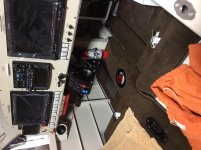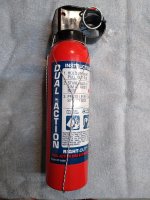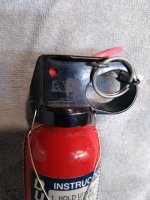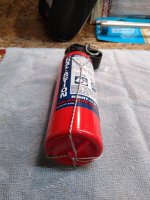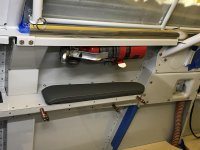I couldn't find any posts in the RV-14 forum on ideas for locating a fire extinguisher. Has anyone installed one and where did they decide to install it? I was thinking a good place might be on the lower forward side of the pilot-side control column cover - easy to reach and out of the way (I think).
Van's Air Force
You are using an out of date browser. It may not display this or other websites correctly.
You should upgrade or use an alternative browser.
You should upgrade or use an alternative browser.
Fire Extinguisher Location
- Thread starter RViator60
- Start date
MED
Well Known Member
I used a VPX, so had a blank spot where the fuses would normally be. I put a tiny halon extinguisher there. Unfortunately, because of height constraints, only the smallest one from ACS would fit, and it has been reported to leak. I weigh it occasionally and no leakage, yet. 
Attachments
Last edited:
The perfect fire extinguisher for my RV-14
Check this out. I got one and keep it in a side pocket next to my leg. Within easy reach, very small, totally reliable. Never needs servicing. Solves every problem I saw in conventional fire extinguishers.
https://elementfire.com/
Check this out. I got one and keep it in a side pocket next to my leg. Within easy reach, very small, totally reliable. Never needs servicing. Solves every problem I saw in conventional fire extinguishers.
https://elementfire.com/
Av8safe
Well Known Member
Element discharge in a cockpit vs conventional extinguisher
The “Element” looks interesting, but it would be nice to have some more information on how it might perform in a small space like an RV cockpit. Also the fact that once you initiate the discharge you cannot stop it, coupled with a 50 second discharge for the smallest unit makes me wonder.
The “Element” looks interesting, but it would be nice to have some more information on how it might perform in a small space like an RV cockpit. Also the fact that once you initiate the discharge you cannot stop it, coupled with a 50 second discharge for the smallest unit makes me wonder.
The “Element” looks interesting, but it would be nice to have some more information on how it might perform in a small space like an RV cockpit. Also the fact that once you initiate the discharge you cannot stop it, coupled with a 50 second discharge for the smallest unit makes me wonder.
I talked with the U.S. rep for the Element. He suggested that there would be no problem using it inside a small cockpit except for the 50 second "cloud". Unless you can vent the cockpit rapidly, this could be a major problem.
I have 4 of them. One in each car, one in the kitchen, and one in the shop.
I am considering carrying one in the airplane placarded "Not for use in flight". It could still be very handy for use on the ramp, or after an emergency landing.
Last edited:
rocketbob
Well Known Member
Chances are high that you will never use your extinguisher on your own aircraft but rather to save the lives of others. I carried two small extinguishers in my Comanche and had to use them both in an attempt to put out a post-crash fire and they didn't do much to help the situation. I now carry some inexpensive but larger BC extinguishers.
Av8safe
Well Known Member
Element product opportunity?
Mel,
I wonder if they have considered a smaller version that would be a viable option for small aircraft?
I talked with the U.S. rep for the Element. He suggested that there would be no problem using it inside a small cockpit except for the 50 second "cloud". Unless you can vent the cockpit rapidly, this could be a major problem.
I have 4 of them. One in each car, one in the kitchen, and one in the shop.
I am considering carrying one in the airplane placarded "Not for use in flight". It could still be very handy for use on the ramp, or after an emergency landing.
Mel,
I wonder if they have considered a smaller version that would be a viable option for small aircraft?
Mel,
I wonder if they have considered a smaller version that would be a viable option for small aircraft?
They actually did have a 25 second model but they discontinued it because no one bought it. He said there's just not enough demand for a smaller version.
I mounted a small Halon on the flap motor cover between the seats.
Same. Worked out well.
With the panel vents open, the cockpit would exchange a lot of air very rapidly. At the very least, you could direct a flow of outside air at your face while directing the cloud from the Element at the fire. Or, open the canopy an inch or so?I talked with the U.S. rep for the Element. He suggested that there would be no problem using it inside a small cockpit except for the 50 second "cloud". Unless you can vent the cockpit rapidly, this could be a major problem.
They do approve it for use in automobiles, and the Porsche club approves them for use in races... They're not a lot more spacious inside than an RV. They do have the benefit of being able to open a window though.
The reality is that any fire in the cockpit in flight is probably going to result in you emptying whatever extinguisher you have on it, while you're trying to get down on the ground. This has the benefit of being something you could start, toss on the floor to keep spraying, and then have both hands free to focus on keeping airflow moving and flying the plane.
I don't know anything about the Element and its potential risk, or lack thereof, of use in a closed environment. I can tell you that Halon works by removing all of the oxygen from the air. It starves the fire of oxygen to halt burning. Unfortunately it also starves the pilot of the oxygen he needs to maintain consciousness.
Might be interesting to further explore this product, as it may be safer than Halon for use in a closed environment.
Larry
Might be interesting to further explore this product, as it may be safer than Halon for use in a closed environment.
Larry
Last edited:
MED
Well Known Member
I don't know anything about the Element and its potential risk, or lack thereof, of use in a closed environment. I can tell you that Halon works by removing all of the oxygen from the air. It starves the fire of oxygen to halt burning. Unfortunately it also starves the pilot of the oxygen he needs to maintain consciousness.
Might be interesting to further explore this product, as it may be safer than Halon for use in a closed environment.
Larry
This is incorrect. Halon interrupts the combustion process, but does not remove the oxygen. That is why it is safe to use in areas where people are present, giving them time to evacuate (think computer rooms). It also leaves no residue to destroy your aircraft. I had an employee accidentally discharge several hundred pounds of halon into a press pit he was cleaning with a steam lance. He came up the stairs a little shaken from the discharge, but with no medical issues whatsoever.
Halon
Online discussions about Halon fire extinguishers invariably include an opinion that if you discharge Halon into an enclosed space, oxygen will be depleted and you will be unable to breathe. Contrary to popular belief, Halon does not remove oxygen from the air. It reacts with all elements of the fire, breaking the chain reaction that sustains combustion. It stops the fuel, ignition source, and oxygen from working together to make a fire, but does not remove the oxygen component.
The FAA and NTSB have looked exhaustively at this because the mistaken belief about oxygen depletion was being promulgated among airline flight crews causing reluctance to use Halon. The results of this study are found in FAA Advisory Circular, AC120-80.
The stated conclusion among others was “the potential harmful effects on passengers and crew [of Halon] are negligible compared to the safety benefits achieved by fighting in-flight fires aggressively.”
While other newer products may be equally suitable, halon fire extinguishers are a long established gold standard for aircraft fire protection, both inside and outside the airplane.
There is one in my current Cessna, and there will be one in my RV-7.
Online discussions about Halon fire extinguishers invariably include an opinion that if you discharge Halon into an enclosed space, oxygen will be depleted and you will be unable to breathe. Contrary to popular belief, Halon does not remove oxygen from the air. It reacts with all elements of the fire, breaking the chain reaction that sustains combustion. It stops the fuel, ignition source, and oxygen from working together to make a fire, but does not remove the oxygen component.
The FAA and NTSB have looked exhaustively at this because the mistaken belief about oxygen depletion was being promulgated among airline flight crews causing reluctance to use Halon. The results of this study are found in FAA Advisory Circular, AC120-80.
The stated conclusion among others was “the potential harmful effects on passengers and crew [of Halon] are negligible compared to the safety benefits achieved by fighting in-flight fires aggressively.”
While other newer products may be equally suitable, halon fire extinguishers are a long established gold standard for aircraft fire protection, both inside and outside the airplane.
There is one in my current Cessna, and there will be one in my RV-7.
The FAA and NTSB have looked exhaustively at this because the mistaken belief about oxygen depletion was being promulgated among airline flight crews causing reluctance to use Halon. The results of this study are found in FAA Advisory Circular, AC120-80.
The stated conclusion among others was “the potential harmful effects on passengers and crew [of Halon] are negligible compared to the safety benefits achieved by fighting in-flight fires aggressively.”
I had not heard of this AC and found it very interesting. However I don’t think it supports your statement above - given our cabins are much smaller than an air carrier I would assume we exceed the “high level” and would suffer all the negative effects halon has to offer? I wonder how many cubic feet a RV14 cabin is so we would work it out?
“ HALON EXPOSURE. Generally speaking, halon is not harmful to passengers and crew; however, various publications, including AC 20-42, caution against exposure to “high levels” of halon in confined spaces, citing the possibility of dizziness, impaired coordination, and reduced mental sharpness. AC 20-42 also provides guidelines that describe what is meant by the term “high level” and further states that these levels should not be exceeded in ventilated or nonventilated passenger compartments on aircraft. However, studies have shown that discharging all of the hand-held halon extinguishers required by regulation in the passenger cabin of an air carrier aircraft will not exceed the maximum concentration levels of halon vapor specified in AC 20-42 or by NFPA 408 guidelines.”
Halon
In addition to the solid research on the subject, I can only provide an anecdotal example of why I have chosen Halon for my RV and Cessna, in addition to the above post about the discharge of large amounts of Halon in an enclosed space having no ill effects on those present.
In my airline career, I have, as have other professional pilots, spent many hours inside an isolated sealed box on hydraulic stilts full of electronics prone to typical aircraft fire hazards, totally isolated with no access to real supplemental oxygen, along with the other pilot and the instructor, commonly called a full motion flight simulator.
Those are protected from fire by massive fire bottles in the simulator bay, filled with Halon, which I doubt would be put there by those who design those things if there was a real risk to the humans inside.
There is no fast escape from flight simulators when they are in use, and it would be impossible to evacuate before the simulator was filled with Halon if a fire were to break out.
Modern advances in fire suppression technology may offer other even better solutions, but Halon is a proven product that does not adversely affect humans in typical uses.
In addition to the solid research on the subject, I can only provide an anecdotal example of why I have chosen Halon for my RV and Cessna, in addition to the above post about the discharge of large amounts of Halon in an enclosed space having no ill effects on those present.
In my airline career, I have, as have other professional pilots, spent many hours inside an isolated sealed box on hydraulic stilts full of electronics prone to typical aircraft fire hazards, totally isolated with no access to real supplemental oxygen, along with the other pilot and the instructor, commonly called a full motion flight simulator.
Those are protected from fire by massive fire bottles in the simulator bay, filled with Halon, which I doubt would be put there by those who design those things if there was a real risk to the humans inside.
There is no fast escape from flight simulators when they are in use, and it would be impossible to evacuate before the simulator was filled with Halon if a fire were to break out.
Modern advances in fire suppression technology may offer other even better solutions, but Halon is a proven product that does not adversely affect humans in typical uses.
Thanks everyone for the excellent comments to my post, that's what makes the VAF great. I'm going to go with the halon extinguisher H3R Model A344T and mount it behind the flap motor panel in the baggage area once I can confirm it would be easy enough to grab in an in-flight emergency situation. I will also buy an Element 50 for the car.
czechsix
Well Known Member
Thanks everyone for the excellent comments to my post, that's what makes the VAF great. I'm going to go with the halon extinguisher H3R Model A344T and mount it behind the flap motor panel in the baggage area once I can confirm it would be easy enough to grab in an in-flight emergency situation. I will also buy an Element 50 for the car.
I wonder if the H3R A344T leaks as badly as the H3R model A400 that I had in my RV-8A. I found that they would only last 2-3 years before they had to be discarded and replaced. Pretty bad for a product that expensive, especially since halon isn't supposed to be released into the atmosphere except for emergency use. I have household & hangar fire extinguishers (standard ABC types) that still have full pressure on the gauge 20 years after purchasing, so there's no reason H3R shouldn't be able to do the same.
a400 loose top
Hey guys,
thanks for all the good tips.
The a400 on my "new to me" RV7A has a top that won't stay on.
I weighed it and it came in just shy of 1.2# certainly usable as a backup.
While I contemplate what to put in the the plane to replace it, I safety wired the top down so its usable again. See attached photo's for detail.
The mounting frame is to blame for the failure. It pry's the top loose from the canister when installed. I'm surprised it did not fail sooner. I flipped the bracket upside down and put the neck pinch holder on the bottom and use the clamp to hold it down.
Standard disclaimers apply; I merely show what I did for my own personal use
Don
Hey guys,
thanks for all the good tips.
The a400 on my "new to me" RV7A has a top that won't stay on.
I weighed it and it came in just shy of 1.2# certainly usable as a backup.
While I contemplate what to put in the the plane to replace it, I safety wired the top down so its usable again. See attached photo's for detail.
The mounting frame is to blame for the failure. It pry's the top loose from the canister when installed. I'm surprised it did not fail sooner. I flipped the bracket upside down and put the neck pinch holder on the bottom and use the clamp to hold it down.
Standard disclaimers apply; I merely show what I did for my own personal use
Don
Attachments
[email protected]
Well Known Member
Element camp
I am in the Element camp for sure. We have them in the race cars, trucks, cars, both sides of both my shops, airplane, hanger x 2, and kitchen. Never need servicing. Work like a flare.
The dry chemical ones need to be shaken up about every 6 months to keep the powder loose. Just bang them on the bottom when they are upside down.
If you pull the pin and squeeze the dry powder that's been setting for a while. It may just go peut and no more cause the nozzle and tube plugged up.
Had a friend who serviced them and he's no proponent of them.
But, do yourself a favor and spend the money and pull the pin and see how long they last. Not very long and the fire may still be going.
I really don't think I'll ever have to use one in my plane, But, the Element runs for as long as it says.
I spent $80.00 and tried one out. WAY COOL!!!!
If I'm going to burn up a $20,000.00 race car I think the $80,00 was well spent to not to. Or maybe somebodies $200,000.00 plane.
My three cents worth Art
I am in the Element camp for sure. We have them in the race cars, trucks, cars, both sides of both my shops, airplane, hanger x 2, and kitchen. Never need servicing. Work like a flare.
The dry chemical ones need to be shaken up about every 6 months to keep the powder loose. Just bang them on the bottom when they are upside down.
If you pull the pin and squeeze the dry powder that's been setting for a while. It may just go peut and no more cause the nozzle and tube plugged up.
Had a friend who serviced them and he's no proponent of them.
But, do yourself a favor and spend the money and pull the pin and see how long they last. Not very long and the fire may still be going.
I really don't think I'll ever have to use one in my plane, But, the Element runs for as long as it says.
I spent $80.00 and tried one out. WAY COOL!!!!
If I'm going to burn up a $20,000.00 race car I think the $80,00 was well spent to not to. Or maybe somebodies $200,000.00 plane.
My three cents worth Art
RV7. I mounted one on the fuel line cover that is under your legs in front of the spar. Perfect location. Out of the way and easily accessible. Going to mount one on the other side as well.
A comment on this as it hasn't been mentioned yet. Mounting a fire extinguisher on the *front* side of any structure is fine if you only expect to use it because of an unexpected fire on the ground or in flight. It will not help you if you expect to be able to use it after a crash. They can, and do, break free of their mounts and end up at the firewall or ejected from the aircraft... Either way, beyond useful reach.
If you can, mount the extinguisher on the backside of something solid, that will help retain it when you hit something. Within reach, too, so the non-crash-related uses are still convenient.
FlyinTiger
Well Known Member
If you can, mount the extinguisher on the backside of something solid, that will help retain it when you hit something. Within reach, too, so the non-crash-related uses are still convenient.
So...where would you mount it? I'm not sure there is a surface like that in the RV. The back of the seats isn't reachable for me or my passengers. Our arms aren't that long.
The full motion sims that I am trained in have an emergency exit button that will shut down motion and allow quick access out of the sim. I was told years ago by an instructor that it was not only due to fire concerns but also due to the need to quickly evacuate the area where halon is used....if someone activates the halon fire suppression system, it sounds an alarm. Not sure if this is for just the fire...In the Navy we were told that halon in a enclosed space can kill you....probably an overreaction but it has alway stuck with me
pa38112
Well Known Member
I talked with the U.S. rep for the Element. He suggested that there would be no problem using it inside a small cockpit except for the 50 second "cloud". Unless you can vent the cockpit rapidly, this could be a major problem.
I have 4 of them. One in each car, one in the kitchen, and one in the shop.
I am considering carrying one in the airplane placarded "Not for use in flight". It could still be very handy for use on the ramp, or after an emergency landing.
Mel, Is there any greater emergency at the moment then a fire in the cockpit? Why not use your extinguisher and then deal with the 50 seconds of cloud? I feel the fire is the greater of the two risks.
It may be a chicken and egg issue..... Fire is usually the cause of the smoke but not always the type of fire you can get to with a handheld extinguisher in the cockpit. It’s the smoke and fumes (caused by a fire) that usually incapacitate the crew before the fire does. After the Swiss Air mishap, airlines went to the full face mask not just due to fire concerns but also due to the smoke and fumes (the crew got their masks on but some investigators believe it did little to protect their eyes). Nothing (IMHO) is more time critical to resolve in a cockpit than smoke and fumes....I would be careful about setting off something that increases the chance of pilot incapacitation (or restricting your ability see enough to fly the aircraft). My personal priority would be getting the airplane safely on the ground as soon as possible, increasing ventilation, and reducing electrical loads.
Last edited:



